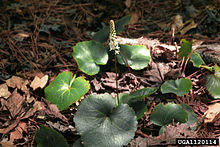| Galax | |
|---|---|

| |
| Scientific classification | |
| Kingdom: | Plantae |
| Clade: | Tracheophytes |
| Clade: | Angiosperms |
| Clade: | Eudicots |
| Clade: | Asterids |
| Order: | Ericales |
| Family: | Diapensiaceae |
| Genus: | Galax Sims |
| Species: | G. urceolata
|
| Binomial name | |
| Galax urceolata | |
Galax, the wandplant, wandflower, or beetleweed, is a genus in the flowering plant family Diapensiaceae, containing a single species, Galax urceolata (syn. G. rotundifolia, G. aphylla). It is native to the southeastern United States from Massachusetts and New York south to northern Alabama, growing mainly in the Appalachian Mountains at altitudes of up to 1,500 m, where it grows in shaded places in forests. Galax urceolata can occur at multiple ploidy levels, an individual may be a diploid (2x), triploid (3x), or autotetraploid (4x) (autopolyploid).[1] The cytotypes are neither morphologically nor geographically distinct, though there are slight climatic differences between the diploid and autotetraploid types.[2] Outcrossing is likely to occur among cytotypes as well.[3]
- ^ Stebbins, G. Ledyard (1950-12-31). Variation and Evolution in Plants. New York Chichester, West Sussex: Columbia University Press. doi:10.7312/steb94536. ISBN 978-0-231-89916-1.
- ^ Gaynor, Michelle L.; Marchant, D. Blaine; Soltis, Douglas E.; Soltis, Pamela S. (October 2018). "Climatic niche comparison among ploidal levels in the classic autopolyploid system, Galax urceolata". American Journal of Botany. 105 (10): 1631–1642. doi:10.1002/ajb2.1161. ISSN 0002-9122. PMID 30239980. S2CID 52310009.
- ^ Barringer, Brian C.; Galloway, Laura F. (April 2017). "The Reproductive Ecology of Diploid and Tetraploid Galax urceolata". The American Midland Naturalist. 177 (2): 299–308. doi:10.1674/0003-0031-177.2.299. ISSN 0003-0031. S2CID 89816057.